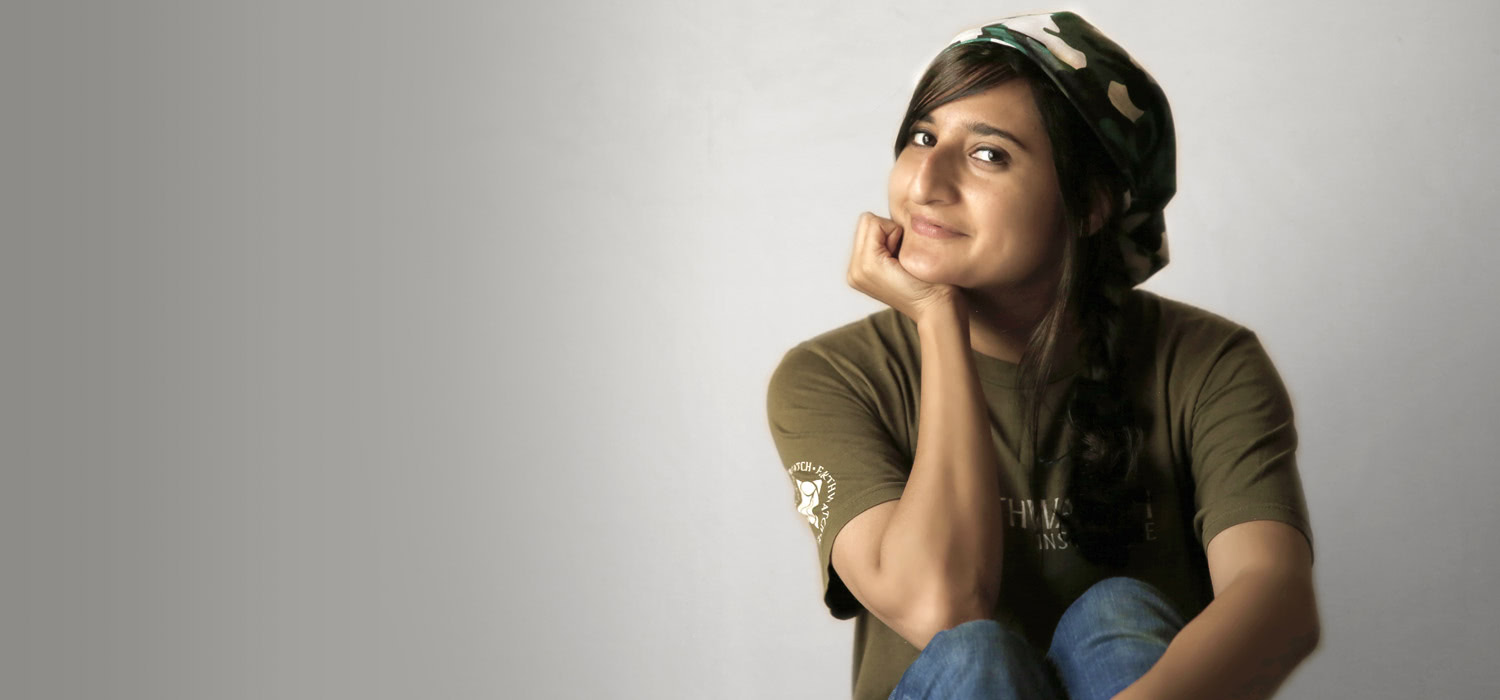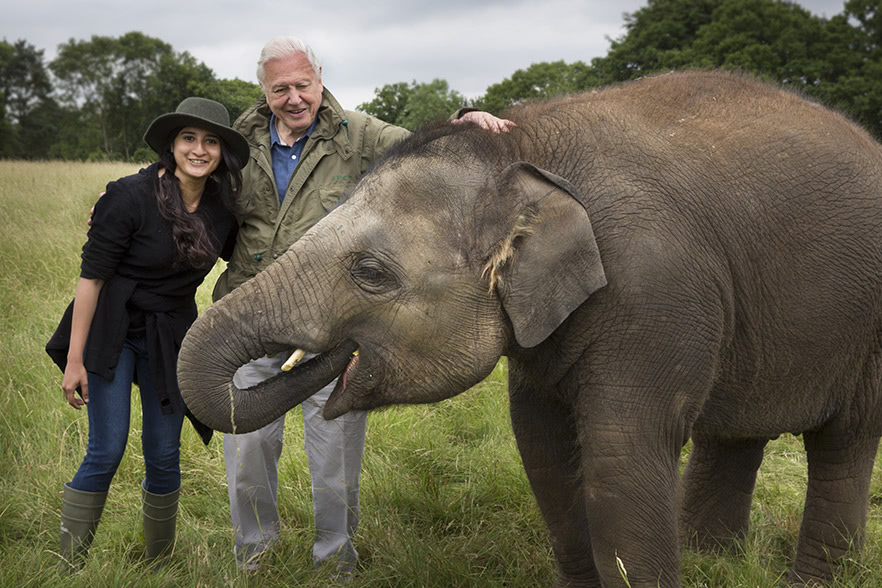
The wild a-calling
Natural history Filmmaking and Communication graduate Ashwika Kapur is smashing stereotypes, using her craft to help address some of the world's most pressing conservation issues – and working with some of its greatest talent.
Otago alumna Ashwika Kapur often enthuses about staring at grass – while it requires great mental and physical exertion the rewards are “moments of absolute joy”.
The joy, says the acclaimed Calcutta-based wildlife filmmaker, comes when a long logistical and creative process culminates in her capturing “unfiltered beauty” on film to tell stories that force us to appreciate nature at its most serene, or red in tooth and claw.
“Nothing happens in the wild unless you are waiting. I'm on location before the sun rises and am the last person to leave. In between I stare at grass for hours on end. This tests mental and physical endurance, but then the reward is moments of absolute joy when you see things that very few, if any, humans have seen 'in the flesh'.”
Kapur's dedication has also gained her a coveted “Green Oscar” for her film about a celebrity parrot and last year saw her work with the biggest name in the world of wildlife documentary filmmaking, Sir David Attenborough.
“Sir David is just as amazing as you'd imagine him to be – and with him at 92 and me at 29, what were the chances of our careers overlapping? I cannot even begin to express what an absolute privilege it was to work with him as part of the five-member crew for a film about the life of Jumbo the elephant. Whoever said you should never meet your heroes was dreadfully wrong.”

Ashwika Kapur with legendary wildlife filmmaker Sir David Attenborough.
Ashwika Kapur describes her profession with the enthusiasm of someone who has found a way to combine a “love” of film – which was gained while working as a child actor in various advertisements and telefilms in India – with a “mild obsession” with animals.
An interest in critters of all descriptions first reared its head when, aged just four, her demands for a dog fell on deaf parental ears. Her mother acceded to a request for another “d” animal, so Ashwika and her leashed duck would subsequently join canine-owning friends on walks through the Calcutta neighbourhood where she was raised.
Her efforts to transform her family's 12th floor apartment into a “fully functioning farm” were finally brought to an end when her parents foiled an attempt to smuggle a goat back from a family holiday in North Bengal. Other inhabitants for the menagerie were found and a list of residents reads: “rabbits (20 plus), rescued tortoise, maina, kingfisher (one of each), white mice (nine plus)”.
A further catalyst for combining her two passions came in her early 20s when she decided not to “live life on autopilot”. At 22 – and contrary to much well-meaning advice – she filled a backpack and swapped a “stable, safe, secure, predictable, conventional life” for one of “chaos and unimaginable fulfillment”.
Initial experiences filmmaking in South Africa led to work opportunities in Kenya, Borneo, India and Nepal.
A special encounter with a two-year-old cheetah called Mzima during a two-week stay at an animal orphanage in Kenya fostered a greater appreciation of just how precarious life is for a growing number of awe-inspiring species globally, and added to her desire to master her craft.
This road to “upskilling” led her out of Africa and to Otago's Centre for Science Communication. She describes studying for her Postgraduate Diploma in Natural History Filmmaking and Communication in 2014 as a “big turning point” in her career, and one which opened her eyes to the genre's endless potential.
“Previously, I regarded the best wildlife documentaries as those with the prettiest pictures, but Otago completely changed my perspective on what constituted good filmmaking.
“I'd studied English literature in India and this was probably why my absolute favourite course was Storytelling in Documentary, which was taught by Ross Johnston. He is a fantastic teacher and a real stickler for a good story! I've since developed my own style and an integral part of this is creating strong storylines.”
While on the programme Kapur single-handedly produced an $800 film about Sirocco, a “celebrity” kakapo parrot. She now jokes about how this low-budget film about a “wonderful little wobbly parrot” completely altered her filmmaking fortunes.
After its release in 2014 Sirocco: how a dud became a stud toured with several international wildlife documentary festivals, was seen in 80 countries and travelled as part of the prestigious Jackson Hole Wildlife Film Festival.
The film also gained a Panda and a Newcomer's Award in the global category at the prestigious Wildscreen Film Festival in Bristol in the same year. The win made her the first and only Indian woman to gain the award and, while it looks great on her CV, Kapur says its real value is as a profile-raiser for wildlife filmmaking in a country where very few women enter the industry.
“There are more male wildlife filmmakers worldwide, but the gender gap is far more pronounced in India. Being a 20-something-year-old camera girl in camouflage throws up a lot of challenges here. So, while there is curiosity, there's also scepticism. But then, anyone who breaks the stereotype faces challenges so I take it in my stride and allow my work to speak for itself. Plus, many wonderful people have extended amazing support.”
Along with challenging stereotypes, raising awareness of important conservation issues remains a core goal.
“I'm a filmmaker by profession, but a conservationist at heart. More than anything else, I'd like my films to be the tools that environmentalists and scientists use to help spread awareness about their work – work that makes a difference to this planet."
"I am always willing to tell a good conservation project story – even if it's small budget – because many important conservation stories rarely end up finding screen time on commercial natural history programmes on television.”
Perhaps referring back to childhood experiences, Kapur says her latest filmmaking project focuses on urban wildlife and how a range of species coexist “cheek by jowl” with India's human population of 1.2 billion.
When asked about a return to New Zealand to explore pressing conservation issues, Kapur enthuses about documentaries exploring reintegration of our native species from predator-free sanctuaries into urban areas.
“New Zealand needs to aspire to having a deafening dawn chorus in every backyard. For that to happen inspirational stories need to be told – stories that will motivate the regular people to do their part to make their own backyards safe for native birds. I'd love to make a documentary on this because, as conservationist Don Merton said, 'they are our national monuments – our Tower of London, our Arc de Triomphe, our pyramids . . . no one else has kiwi, no one else has kakapo'.”
The global equivalent on her wish-list would be a series examining a defining issue for the 21st century: fresh water scarcity. Although largely overlooked by science documentarians, conversations on the issue are gaining momentum everywhere, including in New Zealand.
“The precious resource has been labelled 'the next oil' because of its use in everything from agriculture to industry, energy and manufacturing. Nothing can ever replace water. It's a tough global story to tell on film, but desperately needs to be told.”
While itching to tackle macro issues through her work, Kapur has also found a practical outlet for her conservationism by partnering with the Human and Environment Alliance League (HEAL).
The India-based organisation seeks to educate communities on the need to observe national laws that restrict or prohibit illegal wildlife hunting.
The need for action hit home after she witnessed Bengali tribal communities engaging in illegal annual hunting “festivals”. She was shocked to see boys as young as 12 engaged in the frenzied and unregulated hunting.
“It's impossible to grasp the extent of this massacre until you see it for yourself. The children of these hunting communities have never been taught to look at nature and see beauty so, when I learnt about this, I joined with HEAL to address the root of the problem – a lack of education. We've screened wildlife films, or got the kids to do wildlife quizzes and games, or told them stories to inspire a love for the natural world, and their tremendously positive response has been really heart-warming and encouraging.”
Kapur says her love of adventure has also led to the odd close call, but she describes escaping a flash-flood in the uncharted depths of the Kashmir Valley while looking for bears, or walking around with a “very venomous” newborn Russell's viper snake in her camera's base plate, as going with the territory.
“I've had my vehicle stuck for an hour in the mud in front of a herd of 30 wild elephants. Another time I climbed into a vehicle without realising a lion was sleeping under it. But working with animals can also be hilarious: once a giant male baboon politely robbed me of my packet of biscuits – he was most civil about it.”
Close encounters aside, she describes funding as the biggest hurdle for the wildlife filmmaker.
But then again, “challenges don't feel difficult if you love something”, she says.
“I am doing something that communicates how beautiful and fragile the world is, and it comes from the realisation that the biggest problem in my life was that modern living had made us indifferent to how amazing our planet is. The result is that I choose not to preach to the choir – my films are not aimed at people who already love nature and watch Animal Planet, but for those who aren't interested.”
SAM STEVENS